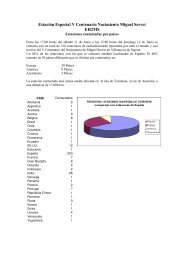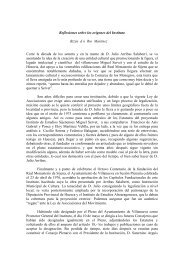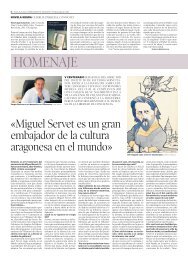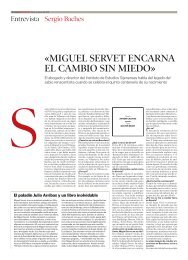New Page
New Page
New Page
Create successful ePaper yourself
Turn your PDF publications into a flip-book with our unique Google optimized e-Paper software.
work, as if an appendix, there are seven antitheses, which contrast the true Christ promised by God and<br />
preached by the Apostles with the one invented by the Antichrist. These theses are strictly of the<br />
dogmatic type, without the vision of Christus pauper outlined above. This sequence of antitheses is<br />
published nearly unchanged in De falsa et vera, Book 2, Chapter XIII. On the other hand, this publication<br />
also describes the way the Lord tears down the masquerade of the Antichrist and restores the true Christ.<br />
This compact passage is nothing but a brief summary of, and identical even in its linguistic formulation<br />
with, a chapter in De falsa et vera.39<br />
What De falsa et vera interprets in more detail apart from John 1 is the first part of the epistle to<br />
the Colossians. The same can be found in the Antitrinitarian publication describing the religious dispute<br />
at Gyulafehérvár.40<br />
With all this in mind, the appearance of István Császmai's work in 1567 should not necessarily be<br />
explained with the fact that the printing of De falsa et vera started in that year already. Especially if we<br />
remember that Császmai's book in all probability was published with a Hungarian text, at least Sándor<br />
András Thordai writing a refutation in Hungarian41 makes it fairly probable. It would seem more logical<br />
to assume that material was being gathered for a representative publication decided on in 1567, and there<br />
was no reason of course why anything from the available text should not be published in advance. For<br />
Géza Kathona is perfectly right when he says that the pictorial material collected with the help of<br />
international cooperation was originally not intended for Császmai's small publication but for the +great<br />
opus". However, it does not follow that we should regard Császmai's publication as the product of a<br />
+casual idea", especially if the events in Poland are taken into consideration.<br />
When after the middle of 1567 the issue of Christ's preexistence had become the focus of debates<br />
among the brethren in Poland, Grzegorz Pawel became incredibly active as a publisher. He had nine<br />
works published during that period. Although only three of these -- Rozdzial Starego Testamentu od<br />
Nowego [The Difference between the Old and <strong>New</strong> Testaments], Okazanie y zborzenie wszystkich Wiar<br />
[Demonstration and Eversion of Every Article of Faith Concerning God], Antychymn Wzgardzonych slug<br />
Chrystusa Ukrzyzowanego [Antihymn of the crucified Christ's despised servants] -- carry the date 1568,<br />
Górski42 has convincingly argued that these were all published between the end of 1567 and the<br />
beginning of 1569. It would seem that this interval, and particularly its most intensive phase, was even<br />
shortened by the fact that after the Synod at Pelsznica in October 1568 Anabaptist socio-ethical doctrines<br />
became dominant as against issues of Christology. The following works published by the Polish<br />
Antitrinitarian are Polish versions of one or more chapters of De falsa et vera: Rozdzial Starego<br />
Testamentu od Nowego, Okazanie i zborzenie, Wyklad mieysc niektorych Pisma [Explanations of a few<br />
passages in the Scripture]. The greatest uncertainty surrounds the work entitled Wyklad mieysc niektorych<br />
since there are no extant copies. Górski has tried to reconstruct its contents on the basis of contemporary<br />
and later descriptions, and sees a connection with Chapters IX through XIII, and XV of De falsa et vera.<br />
The work entitled Zgodne a iedne rzecz znamionuiace [Places agreeing and identical in meaning] merits<br />
special attention. This in part corresponds to Chapter XIV of the collective work, but it has been shown<br />
that Grzegorz Pawel used the separately published polemic sheet, Aequipollentes ex scriptura phrases.<br />
All we have said so far can be summed up in a table (Appendix I.)<br />
On the basis of the above, August 1568 as the publication date of De falsa et vera should be interpreted<br />
in a different way. The parallelism we can perceive in the procedure of the Poles and the<br />
Transylvanians suggests that it was within the framework of concerted tactics that they published before<br />
the famous work, which would appear as a joint publication, those of its parts which they, each according<br />
to their views, found important. Dávid and his friends, simultaneously with their brethren in Poland,<br />
wanted to make a breakthrough in the propaganda in Hungary, so that the joint publication register their<br />
position at the same time for both the increased number of their followers in Hungary and the +world at<br />
large".<br />
16







